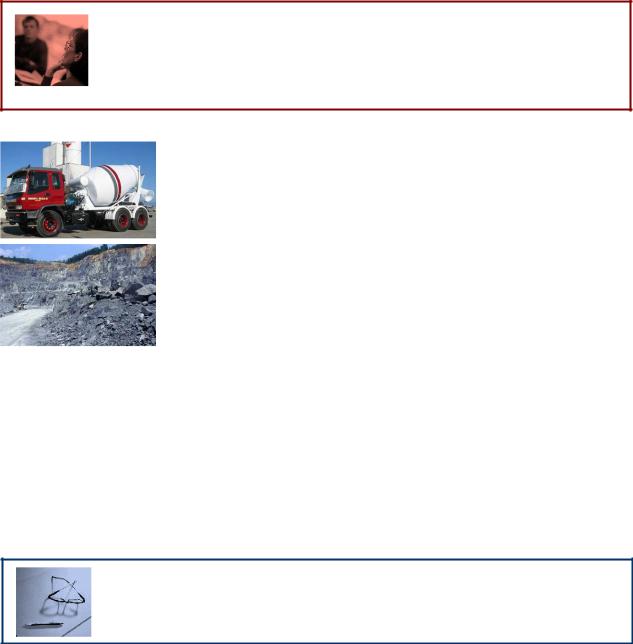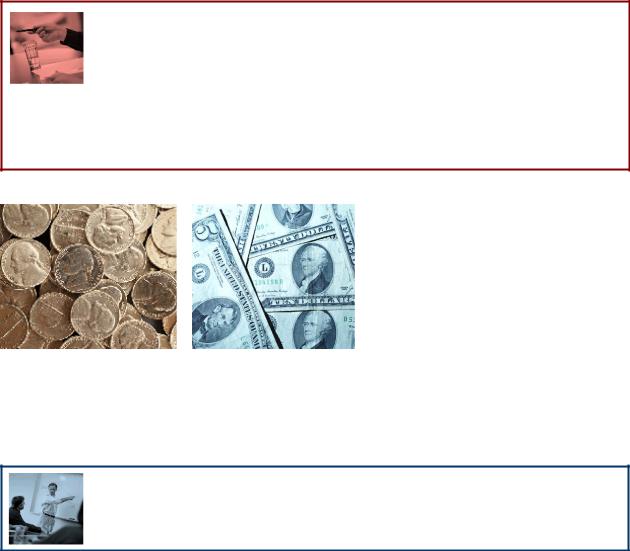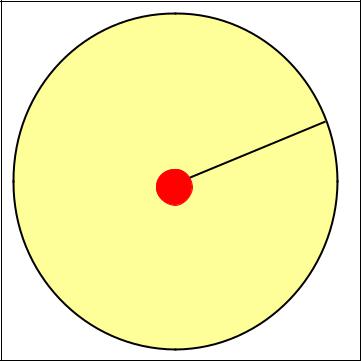
Ace_The_Case_2nd_Ed
.pdf
Business Problem:
If you were given the option between owning a concrete business or owning a quarry what would you choose and why?
A quarry extracts rock and stone from the earth often in ‘open-cut’ style excavations. Although quarry’s can extract anything from, simple rock to marble they often supply much of the raw material for concrete production and are therefore the first link in the supply chain of the concrete industry. A cement business uses raw materials such as lime, sand, clay, calcium and other minerals to mix and produce the substance of cement. This cement product is then distributed still moist to construction sites. In this case question you have been
given the choice of deciding which business you would prefer to own. This question will test your analytical skills and is a clever way of revealing to the interviewer what type of business person you are. E.g. high risk, low risk, future oriented, micro or macro focus etc. You may at first want to base your decision on long term profit opportunities, however a sound and complete analysis based on a model such as Porters 5 industry forces, or even a SWOT analysis is what will impress your interviewer.
Discussion and Possible Solution:
Porters 5 forces industry analysis model would be ideal for answering this question, however since it was already demonstrated in an earlier question, a framework known as a SWOT analysis will be used here instead. If you don’t already know, a SWOT analysis provides a careful evaluation of an organisations internal strengths and weaknesses as well as its environmental opportunities and threats. It provides a holistic view of the organisation considering both internal capabilities and external forces. It is therefore more than suitable in answering this case question of comparing two businesses at different stages in the supply chain. Each business will be looked at and analysed using the SWOT analysis and then a judgement call will need to be made based on which business has the strengths and opportunities that can really be capitalised on and the weaknesses and threats which are more easily avoided or mitigated. You may want to
www.AceTheCase.com |
- 81 - |
Copyright 2007 |

interact with the interviewer asking for more information about each business if possible. The swot analysis may end up looking something like this:
A Concrete Business
STRENGTHS
Opportunity for product innovation. I.e. Different mixes
Higher priced end product
OPPORTUNITIES
Increased chance for growth through expansion and take overs etc.
WEAKNESSES
Once product is made it must be delivered immediately
Liability if concrete quality is poor
High cost of plant/factory, including maintenance
Process intensive and Logistically challenging
THREATS
Price can be dictated by suppliers and input mineral resource prices
Output dictated by construction market
Substitutes available
High Competition
www.AceTheCase.com |
- 82 - |
Copyright 2007 |

A Quarry Business
STRENGTHS
Little input costs and resources.
Large number of buyers
Product already exists in the ground
Generally a larger company with higher profits
Start of the supply chain
OPPORTUNITIES
Low Competition and high barriers to entry
Can operate more globally
Can forward vertically integrate and buyout cement plants
WEAKNESSES
Little opportunity for change or innovation
Low priced product
Growth opportunities more limited
THREATS
Natural resources can always run out
Government legislation & environmental protest
Market price fluctuations
From the SWOT analysis you may like to state that a quarry business is the preferred option if you were a business owner. Minimal competition, global opportunities, being at the start of the supply chain, having a large number of buyers and no input resources other than machinery and labour is definitely favourable, however low growth opportunities is a downside. Essentially you could really argue for either business. The strength of your SWOT analysis and later argument are the things that will impress the interviewer.
www.AceTheCase.com |
- 83 - |
Copyright 2007 |

Business Problem:
A retail bank is expanding and wants to know where the optimum locations are to put its bank branches. How would you go about creating a model or framework for solving this? Consider a macro perspective i.e. not what specific street or block to put it on rather what suburbs, towns, districts or areas.
The location of a physical business shop front is always important when considering customers who must visit the premises. For an expanding bank this importance should be no different. This case
question is challenging but can be made simple by introducing the concept of a population critical mass. You may remember this from an earlier question in the guide from the estimation and market sizing section.
Possible Solution and Discussion:
The first point to mention to the interviewer is that generally speaking similar shops and businesses which have customers who must come to them are found close together. Consider the location of clothing stores in shopping malls, car dealerships & car yards along a stretch of road and restaurants along a river side promenade. Bank branches are somewhat similar to this general rule so this should be the first aim and is in fact a micro perspective aim.
Now in terms of developing a macro model for the optimum location of bank branches you will need to discuss some more ideas with the interviewer:
Explain your understanding of a population critical mass by saying the bank probably requires a minimum population figure (i.e. potential customers) before it will open a bank branch in any location. If it has a 10% share of the local market and requires 5,000 bank accounts/customers to make the branch feasible. Then a population critical mass of 50,000 is required in the area. Say a 5 mile radius.
www.AceTheCase.com |
- 84 - |
Copyright 2007 |
Now you may want to extend this idea and explain that since bank branches operate in the day, service business customers and individuals the population critical mass should probably be more of a day time figure, therefore taking into account where people work, live, the location of businesses etc.
Since you must also be of a certain age to open a bank account those under the age of maybe 6 can be eliminated from the model.
Bank branches differ in size between large and small so perhaps two critical mass figures can be used for two different sized branches (Large and Small) which ensure that those living in smaller townships which do not even reach the initial critical mass are not overlooked. Or perhaps the critical mass area radius can be widened for less populated areas such as country towns.
With these initial ideas out in the open you can begin to formulate a model using diagrams, equations and graphs.
So far you may have some variable such as:
Number of Residents: R
Number of Workers: W
Number of Business: B
Critical mass of larger than X for large branch
Critical mass of between Y & X for small branch
Area radius of Z miles for heavily populated areas
Area radius of 10Z miles for less populated areas.
Using these variables you may draw a diagram such as that below to explain the conditions which must be satisfied for a large branch to be put in a heavily populated area:
www.AceTheCase.com |
- 85 - |
Copyright 2007 |

Conditions for Bank Branch in Heavily
Populated Area
ƒ(R,W,B) > X
Z miles
As can be seen some function of the number of residents, number of workers and number of businesses must be larger than the critical mass figure within an area of radius Z miles.
The function may be something as simple as:
R/4 – (number individuals under 12) + W/4 + B/2
So if there were 60,000 residents in the area, 6,000 residents under 6 20,000 employees during the day and 2,000 businesses. You would get a critical mass figure of:
60,000/2 - 6,000 + 20,000/2 + 2,000 = 36,000
If the critical mass figure for a large branch is 30,000 then the area under question would get a large bank branch as close to the centre as possible not forgetting to take into consideration the earlier micro goal of placing bank branches close to one another or at the very least near a shopping mall, or other commercial area.
www.AceTheCase.com |
- 86 - |
Copyright 2007 |
If the bank required a critical mass of more than 40,000 for a large branch and between 20,000 and 40,000 for a small branch then in the above example the area would get a small bank branch.
Similar logic is applied to less populated areas by increasing the radius of the critical mass area.
You now have a simple working model to show the Bank. They must determine the required critical mass number and area based on their existing bank branches, expansion strategy, expected market share etc. You could then obtain vital population, demographic and business data from local and national statistics bureaus for target states and cities and the model is complete.
www.AceTheCase.com |
- 87 - |
Copyright 2007 |

Business Problem:
A CIO / IT Manager wants to analyse his IT application portfolio. How would you go about segmenting this?
This is a short case question and will predominantly involve a discussion with the interviewer around some key ideas. It is a different style of question since it appears on the surface to be very much IT specific, however once you start thinking about the problem it is simply a question designed to see how you solve problems, think about a business and categorise things. Having an IT background may be an advantage, but having strong business
instinct and problem solving skills is probably more important in brainstorming possible solutions.
Possible Solution and Discussion:
The first thing that should be discussed is the motive or goal of the CIO in analysing the IT application portfolio. Does he/she want to ultimately minimise the number of applications in use within the organisation, cut costs by reducing technical support staff, design/purchase and introduce new software applications, enhance security, formation of new outsource relationships, or simply neaten the current application situation by consolidating redundant and old systems. Is the exercise part of a larger risk management initiative or something required by external auditors? Points such as these should be raised initially to show the interviewer that you recognise the importance of first truly understanding a problem before attempting to solve it.
The interviewer may then select one of the motives above to help you narrow the scope of the problem, and formulate the best method of segmentation. Below are some simple options for segmenting an IT application portfolio.
www.AceTheCase.com |
- 88 - |
Copyright 2007 |
Organisational Value: The first option for segmentation may be based on some estimates around value to the organisation. Looking at all the applications, data and estimates could be combined to determine how much revenue would be lost per day, or costs incurred if the application disappeared or was down. Both tangible and intangible impacts would need to be considered however and this may become hard to quantify, leaving a bias towards transaction processing based software.
Total Cost of Ownership (TCO): Similarly the IT applications can be categorised based on the total costs it brings to the organisation. TCO is a common term in IT management as it is something that should always be minimised. TCO includes such things as the initial build/purchase costs as well as ongoing support and maintenance costs, any associated hardware costs licensing fees etc. This method of categorisation however may leave a bias in favour of small, low cost applications.
Business Process: Another way of categorising IT applications may be to look at what business process they support. Business processes may include such things as sales, marketing, manufacturing, purchasing, distribution, payroll, accounting etc. For instance 4 different applications to process purchases from suppliers could be considered somewhat inefficient and perhaps the differing functionality could be consolidated into one application.
Users or Organisational Spread: A simple method of categorisation may be to look at how many people within the organisation actually use the application, or how many instances of installation are there? For instance a piece of software may have been purchased along with licensing for 100 users. If only 20 people are found to actually use it then perhaps the licensing arrangements can be scaled back or future software purchases and license agreements looked at more carefully. Also imagine applications for processing sales orders which are different in the organisations 6 offices around the country. These 6 applications could probably be consolidated into one application reducing costs dramatically.
Technology Platform: The last option we’ll mention is in relation to the underlying technology involved with the application. Categorising the application portfolio based on such things as which organisational Data Base it uses, what type of data base, language it is written in, whether it is web based, server based or locally installed, Windows based, UNIX, Mac or Linux? May all help in categorisation. For example the CIO may want to remove /replace all systems which use Oracle databases in preference of
www.AceTheCase.com |
- 89 - |
Copyright 2007 |
SQL data bases. Determining which applications use a data base and of these which ones use an oracle database is therefore of importance.
You may have other great ideas in addition to these possible methods of categorisation as the above is just a sample of a multitude of possible solutions. You may want to conclude the discussion by reaffirming the need to first understand the CIO’s motivations and goals in respect to the IT application portfolio and that if quantifications are to be made regarding organisational value and costs a balanced approach should be taken i.e. a variety of approaches could be used and combined to ensure intangible benefits and costs are not missed and that the inherent bias of some of the above methods does not directly show through in any final evaluation and hence decision. As a simple example, there is no point removing the organisations largest application which may be a huge ERP system because it has the largest cost of ownership and uses an oracle database.
www.AceTheCase.com |
- 90 - |
Copyright 2007 |
